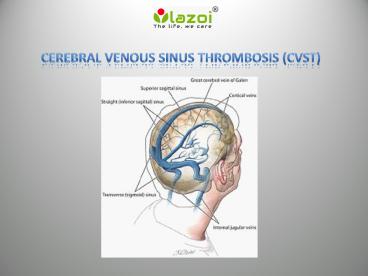Cerebral Venous Sinus Thrombosis (CVST) - PowerPoint PPT Presentation
Title:
Cerebral Venous Sinus Thrombosis (CVST)
Description:
Cerebral venous sinus thrombosis (CVST) is the presence of acute thrombosis (a blood clot) in the dural venous sinuses, which drain blood from the brain. Symptoms may include headache, abnormal vision, any of the symptoms of stroke such as weakness of the face and limbs on one side of the body, and seizures. – PowerPoint PPT presentation
Number of Views:1265
Title: Cerebral Venous Sinus Thrombosis (CVST)
1
Cerebral Venous Sinus Thrombosis (CVST)
2
Cerebral Venous Sinus Thrombosis (CVST)
- Blood are transported through arteries in brain
to deliver oxygen and nutrients, after the work
is done are blood is taken back to the heart by
small veins released into large veins and then
from neck to the heart. Blood clot in the vein
which carries blood back from the brain to the
heart is called cerebral venous sinus thrombosis,
in common term as cerebral thrombosis. There are
many names of this disease called by doctor such
as cerebral venous thrombosis, cerebral vein
thrombosis etc.
3
Symptoms of CVST
- Obstruction of blood flow from a clot in vessels
lead to back up of blood and increasing blood
pressure in the blood vessels which can cause
swelling of the affected area. - The swelling leads to headache, the pressure can
damage the blood vessels and show stroke like
symptoms. - The increased pressure can also lead to rupture
of blood vessels and bleeding into the brain. - The phenomenon is known as "Cerebral hemorrhage",
it can lead to further damage of brain tissue. - Blurred Vision, Fainting and loss of
consciousness, Seizures - Cases of CSVT are very low, as of 5 in 1 million
people in adults, and 3 in 1 million people in
children's under age 18.
4
Causes of CSVT
- The major causes of CSVT in the newborns are
infection. Infection of the inner ear (otitis),
the bone behind the ear (mastoiditis), the mouth,
face or neck can be the causes. - There can be other factors such as hormone
therapy, birth control pill, certain medications
can increase the risk of it. - Pregnancy can also be the cause of CSVT.
5
Risk factor of CSVT
- Children Showing major risk factors are-
- Children's have the major risk of having CSVT in
the first month of their birth. The disease can
be inherited from the mother to the child. - Child with problems with the way their blood
forms clots such as sickle cell
anemia, Beta-thalassemia major, chronic hemolytic
anemia. - Heart disease - either congenital (born with it)
or acquired. - Iron deficiency
- Certain infections
- Head injury
- Risk factors for adults include
- Pregnancy and the first few weeks after delivery
- Problems with blood clotting.
6
Risk factor of CSVT
Continue
- Cancer
- Collagen vascular diseases like lupus, Wegener's
granulomatosis, and Behcet syndrome - Obesity
- Low blood pressure in the brain (intracranial
hypotension)
7
Treatment of CSVT
- The foremost treatment for CSVT is by giving
anticoagulant to the patient. Anticoagulant
dissolves blood clot and avoid from further
arising of blood clot. - Anticoagulants such as heparin and other blood
thinners can help. - For the thrombosis which is caused by infection,
antibiotics are given for its prevention. - Certain severe thrombosis can also lead to coma
of the patient, in that case keeping the patient
in intensive care unit and continued monitoring
of the patient is needed. - Ant seizures are also provided to reduce any
seizure in the brain.
8
Diagnosis of CSVT
- The first method used to diagnose a clot or
bleeding in the blood is by CT or MRI scans. - But in most of the cases the bleeding can be
missed in these two techniques, so
a Venography of vein should be done where images
of the vein are taken are taken to know about any
particular bleeding in the vein. - In the condition of deep vein CSVT a MRI
venogram is more preferred over a CT venogram. - Certain blood tests can be done to know if any
infection is present in the body which can lead
to the condition of thrombosis. - Through CSVT is an uncommon disease, it can be
very fatal if neglected. Certain severe cases can
lead to coma or even death. Proper evaluation of
symptoms and knowing of the risk factors in early
can stop the condition from getting fatal.
9
CONNECT WITH US
- Logon to
- www.lazoi.com
- Like us on Facebook
- https//www.facebook.com/LazoiTheLife
- Follow us on Twitter
- https//www.twitter.com/lazoithelife
- Follow us on Pinterest
- https//www.in.pinterest.com/lazoithelife

